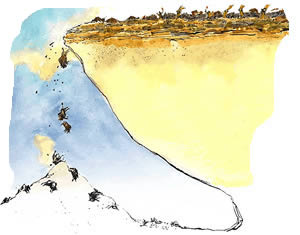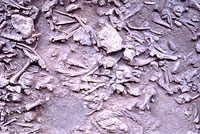Earliest Buffalo Jump

Bonfire Shelter on the western fringe of the Lower Pecos canyonlands has the twin distinction of being both the earliest and southernmost bison (buffalo) jump site known in North America. Here early Paleoindian peoples ingeniously stampeded herds of bison over the edge of a cliff overhanging this large rockshelter. The bison plunged to their deaths on a rocky pile at the opening of the shelter, providing a sudden wealth of meat, hides, and bone to the hunters.
Located in a narrow box canyon that empties into the Rio Grande near Langtry, Texas, Bonfire Shelter has seen several mass kills. The first definitive jump episodes occurred over 11,700 years ago (9700 B.C. or earlier) during the Paleoindian era at the end of the last Ice Age (Pleistocene). At least three separate events created what archeologists call Bone Bed 2, a layer in the shelter's deposits containing the bones of a now-extinct species of buffalo (Bison antiquus or B. occidentalis) as well as a small number of stone tools including Folsom and Plainview projectile points. A 10-section exhibit tells the story of Bonfire Shelter including an even more-massive bison jump episode that occurred almost 8,000 years later in Late Archaic times.
